A Young and Radical Perspective in the Italian Media Sector
This article is part of Reset! Yearly Focus 2025: Reclaiming Spaces
Author: Matilde Moro
Amid Rome’s housing crisis and a faltering media landscape, Scomodo has emerged as a bold voice for a new generation. Founded by teenagers and based in an occupied building turned community centre, this radical magazine blends journalism with activism, offering long-form, collective storytelling rooted in lived experience. With its roots deep in social movements and a vision shaped by youth, Scomodo is not just reporting on change—it’s making it.
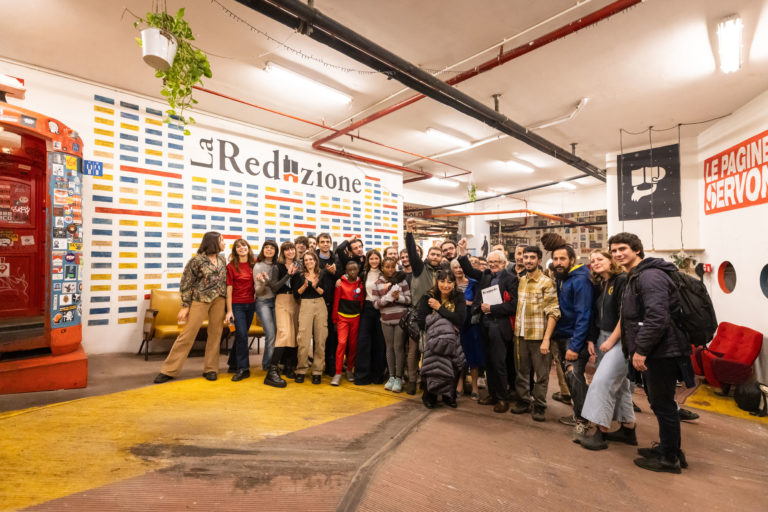
Inside Scomodo's newsroom at Spin Time – © Scomodo archives
Rome, May 2025. Spin Time is a 10-stories, 20.000 square meters building in the Esquilino neighbourhood. This immense, vaguely fascist-looking construction used to be the headquarters of the National Institute for welfare and assistance for civil service employees. It was first vacated in 2003, and completely abandoned by 2010.
In 2013, it was occupied by the movement for the right to housing Action. Today Spin Time is home to more than 150 families affected by the housing crisis—with people from 27 different countries currently living there. The space slowly managed to gain recognition in Rome as a virtuous example of urban regeneration. Since 2019, Spin Time also houses the under-30 magazine Scomodo (literally translating to Unconfortable). The newsroom, located at the -2 floor, hosts much more than a mere editorial project: Scomodo is home to a lively community, constantly organising events and debates, free, and accessible for all. It is no chance that Scomodo ended up finding its first home in a space like Spin Time.
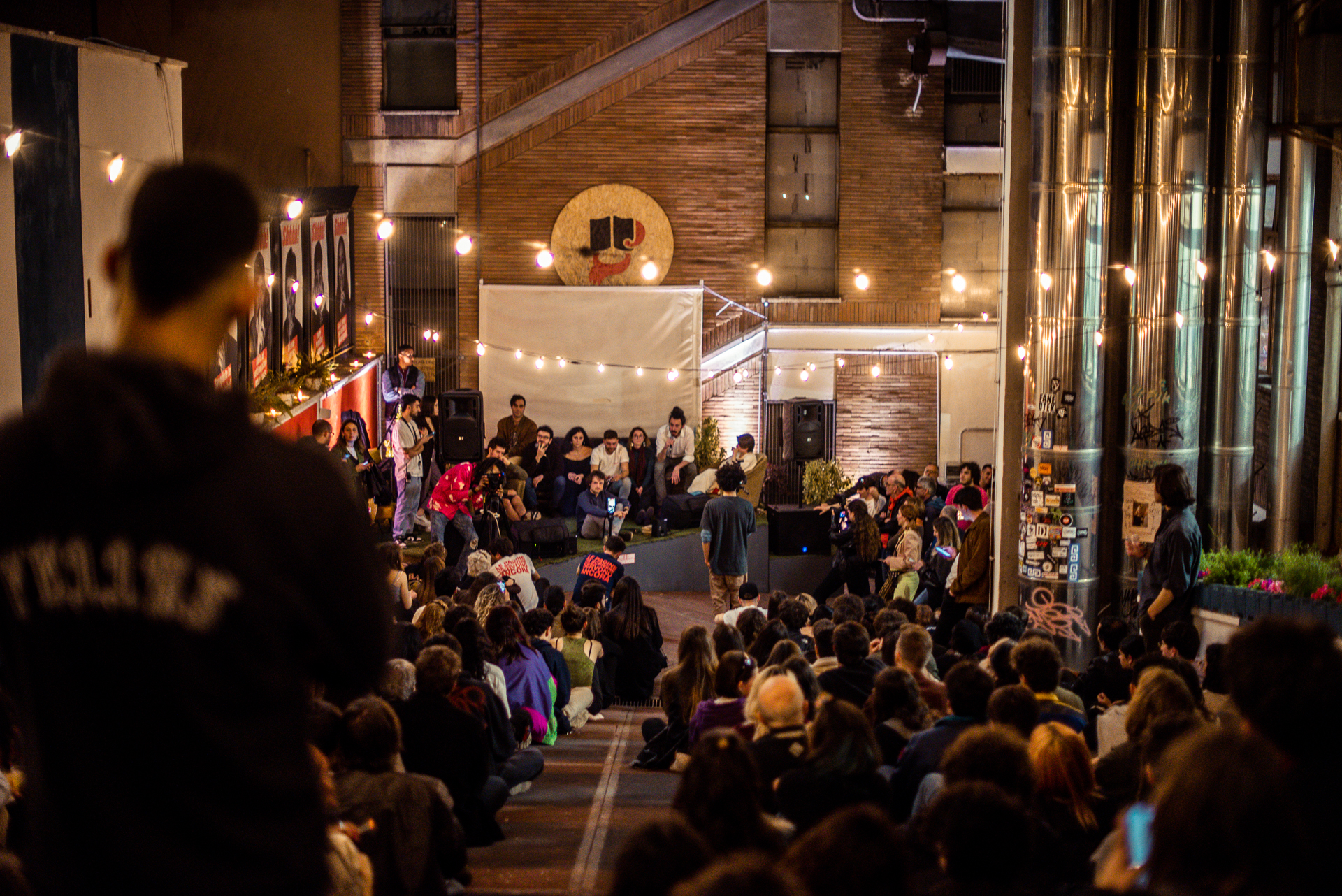
Scomodo organises debates on social and political issues all-year round – © Scomodo archives
From Community to Editorial and Back
“We were born in 2016 in Rome,” recalls Scomodo co-founder Edoardo Bucci, “in a fairly complex social and political time for the city, in which the room for self-organisation, social movements, and political collectives was shrinking.” At the time, Bucci was as young as 16: a highschooler in Rome, with the urge to do something. At first, the project was an almost instinctive response to a necessity that the generation they belonged to felt strongly: “We felt the need to give an answer through different tools and canons.” It was all about the raw desire to reclaim the political, social, and cultural space they had been denied. Then the desire to focus on raising awareness, encouraging participation, and providing information emerged. The growth was fast—and proof that the need they had perceived was shared by many: “at the beginning, in June 2016, we put together 20 or 30 people, but by September we had already reached an assembly of more than 100 people.” The base, from the very beginning, was completely collective in nature—a hybrid between a social and an editorial reality. What was born that summer is a bold and radical journalistic project that is slowly transforming the Italian media industry in the face of obsolete editorial groups.
Scomodo’s hybrid nature went on to remain one of the pillars of the magazine, when the first issue—printed in 10,000 copies and distributed free of charge in schools and universities—came out in the early summer of 2016: “we financed it through the occupation of a school that lasted two days, we created this incredible event with more than 5,000 people and with the earnings we paid for the magazine.” At that point, everything was still very instinctive: “we did not have much experience, I myself was only 16, but our roots were already there, and so was the determination to produce long-form articles with certain editorial research. The idea was already to intercept this lack of new instruments to allow new generations to express themselves.” An idea that remained—along with the new-born business model.
Indeed, the first event translated into the “Notti Scomode” (Unconfortable nights) format: a party series in abandoned areas of Rome, “re-qualifying them for one night,” in Bucci’s words. This approach circles back to the social nature of the project: a forgotten area gets to be seen, considered, lived, even if only for one night—and in turn, Scomodo gets to be printed once more, offering long-form, thought-provoking, socially-oriented information, in a virtuous exchange: “we build this circular mechanism where we reinvested all the money from the parties in the printing of the magazine and the development of the editorial projects, which gradually acquire more and more form and structure.” No digital subscription, no over-expensive traditional products: Scomodo lives on by directly involving the same community it is aiming to inform.
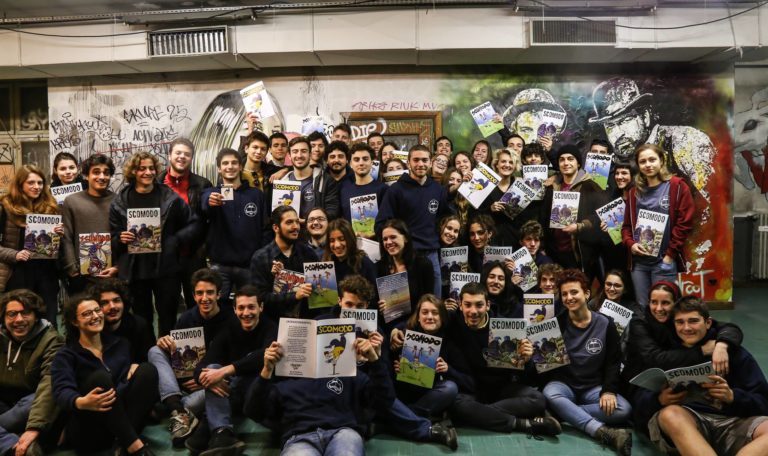
The launch of a new Scomodo issue – © Scomodo archives
Taking Political Responsibility
Scomodo and Spin Time’s paths crossed in 2020 “even though,” Bucci explains “there was a connection from our very early days, when we did not have a place to meet, Spintime offered us a room to get together for our endless discussions.” A few years went by, and in 2020 the building manager approached the team with a proposal: floor -2, the former garage of the building was still completely abandoned–why not turn it into a newsroom? The process, Bucci recalls, involved hundreds of people: “we launched a huge public campaign where we asked people to donate either money, some of their time, or materials to transform the space—a thousand people showed up to help, from professionals to kids. It was total chaos, but together we made it.” Once again, community at the core—as it turns out, if you ask people to come together, sometimes they do.
Living as a community inside a space like Spin Time changed the game for Scomodo on many levels. A transformation that started from abandoning a comfort zone to join a more complex reality: “it is really an extremely interesting place of political confrontation, especially for a community of under 20s, as there are 30 other cultural associations and 400 people live there from 27 different nationalities. It is a complex and stratified context, so rich in the political and cultural dimension, it has certainly played an important role in our individual growth.” It is also about picking a side, making a choice, and living with the political responsibility that comes with it: “although there are promises of legalisation, it is still an occupied building, so we know we could be evicted at any time—just like the rest of the community living there. This makes ours an activist choice, a choice of resistance and of being in a space and believing in what this space stands for, while taking on the legal and political responsibilities that come with it.” In turn, this also reflects on the editorial quality of the pieces Scomodo produces: “when we talk about the housing crisis, we talk about it from a privileged perspective, but from within Spin Time, and we have a close experience of the subject we are talking about.”
Spin Time is also an example of a different way of living—always inspired by a community-first approach to finding radical solutions for the housing crisis. And a fruitful one: just to mention one of the clearest indications of how successful Spin Time has been, the school dropout among the 150 families who live in the upper floors is 0%, compared to 10.7% across Rome. The collaboration with Scomodo, just like with the tens of other projects that found a home in Spin Time, is in the name of “mutual influence”. People who live in the upper floors are welcome to participate in the newsroom, the events, and the community as well as the opposite—creating constant opportunity for mutual inspiration.
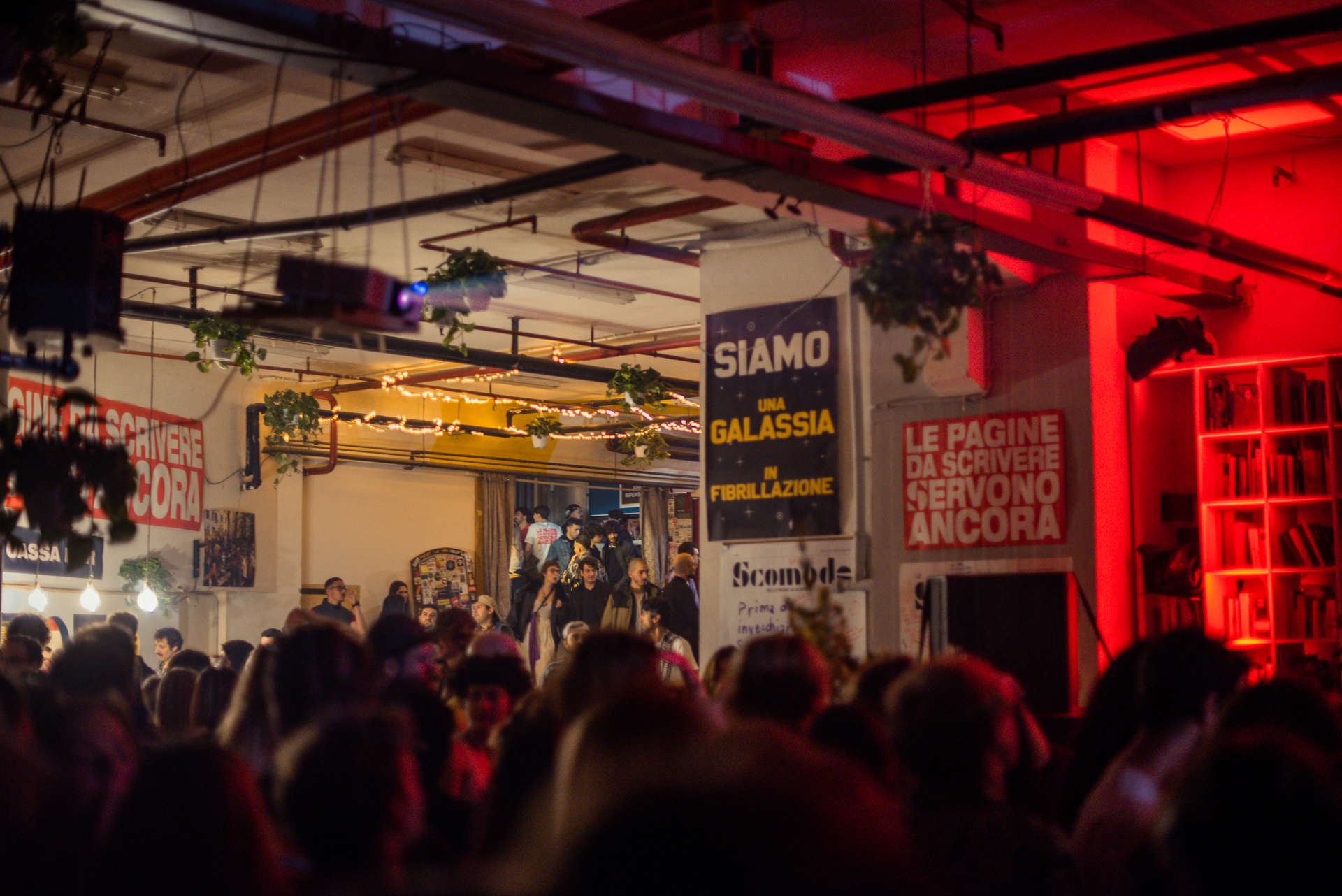
We are a galaxy, relying on community to write words – © Scomodo archives
Making a Radical Difference in Practice
The creative process underlying most of Scomodo’s magazine issues also starts from its community: “we hardly ever publish pieces written by a single person,” Bucci explains, “from the very beginning the idea was to approach journalism as a militant, collective, and shared practice.” In an editorial system mostly relying on the single, powerful signature, as it is the case for most Italian media, this is a radical choice in itself. Scomodo wanted to offer something different, in the face of the saturation of “opinionism” and of this strong signature system. They started working in groups, up to seven or eight people, often sharing different perspectives, experiences, ages. It is a process that takes time, but “it means to be able to do a deep territorial work, to listen to many people, talk to experts, hear common people out as well, and then compare different opinions.” Taking the time and working slowly is also a choice for Scomodo: “our work is based on slowness and has always reclaimed slowness as a necessary condition both in the fruition and in the creation of content.” In an ever more fast-paced media environment, acting slowly brings on a refreshing perspective—that goes hand in hand with favouring quality and complexity over simplification.
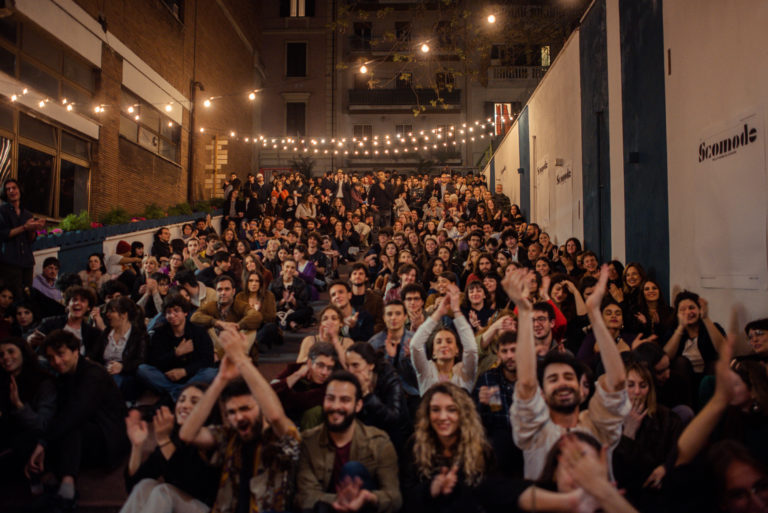
If I can't dance, it's not my revolution, a party at Scomodo – © Scomodo archives
Looking Forward into Adulthood
Scomodo’s history, as an emerging project in a complex and at times hostile media environment, has always been filled with questions. And even after almost ten years of successful activities, with many of the staff having managed to turn their passion into a job, as well as paying for external contributors, they still ask themselves: “Is it possible to continue doing this? That is, to make this project a life choice, or is it no longer possible and it was just a nice generational experiment?.” Of course, the answer was yes. It was time, as the Scomodo community found out by asking these questions, to become adults. The way forward, they decided, was in their founding principles. “The plan now is to open five new spaces in the next five years, from 2025 to 2030,” explains Bucci, in order to bring Scomodo across Italy, discovering and building new communities. The first city will be Milan: “we have already bought a space, and we are confident we will open it to the public by the end of the year.” The idea is to replicate what they did in Rome, though differently according to each territory: “we want large spaces where people can meet and create a community just like it happened in Rome.” In order to fund this, they are relying on a People’s Shareholding model—a fundraiser based on the idea that becoming part of this movement means investing in the community and believing in the common strive for social cohesion. The idea is to then start focusing more on the specificities of each territory, developing local as well as national editorial products.
The process will not involve only big cities. Together with the larger spaces, which Bucci says will probably be in bigger cities, Scomodo is also working with suburbs, boroughs, and smaller municipalities: “we don’t want Scomodo to be just for big urban centres.” Empoli was the first example, and more are coming. As the community expands, Scomodo is becoming adult also by staying young—“when we started, we pledged to leave our positions at 30 years old, to make space for younger generations.” With no intention of surrendering to the cynicism of the Italian media industry, Scomodo is going forward following the same, radical compass as ever: to grow the project, and nourish the community.
Published on July 22nd, 2025
About the author:
Matilde Moro is a freelance journalist currently based in Tbilisi, Georgia. She has published reportages from Ukraine, The Occupied West Bank, Albania, The Slovenian-Italian border, the Italian-French border, collaborating with Italian and international publications like Editoriale Domani, L’Espresso, and Unbias The News.